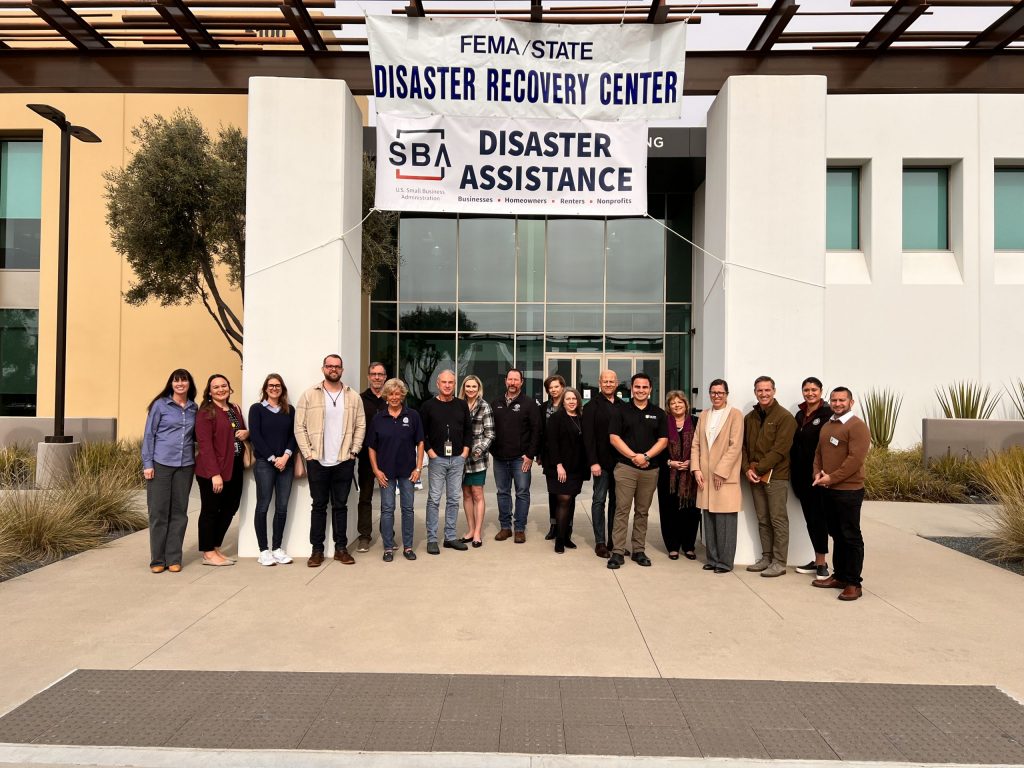Officials gather to discuss options available to the public following storm
IN THIS ARTICLE
- Central Coast Topic
- Madeleine Benn Author
By Madeleine Benn Thursday, February 2nd, 2023

With the near-record storm behind the Central Coast, all that is left now is to pick up the pieces.
The Federal Emergency Management Agency (FEMA) and the Small Business Administration (SBA) have been the ones trying to accomplish that goal, teaming up to provide the tri-counties with a slew of help.
“Partnering with FEMA and the Small Business Administration Office of Recovery and Resilience opens up our federal low-interest loans to homeowners and renters, not just businesses and nonprofits,” Zabrina Tipton, a public information officer for the SBA, said during a coordinated meeting in Santa Barbara on Feb. 2.
“If somebody is working with FEMA, FEMA will refer them to us if this is the direction that they need to head to, then the Small Business Administration works with the disaster survivor, whether it’s a homeowner or renter or a business.”
The meeting was held at the Direct Relief offices where the Santa Barbara County disaster recovery office is located for Southern Santa Barbara. There is also a disaster recovery office in Santa Maria.
The meeting had officials from the Santa Barbara Governmental Leadership, the SBA Los Angeles District Director, FEMA, SBDC, the Chamber of Commerce, and the Economic Development Collaborative.
The groups discussed steps businesses, nonprofits, homeowners and renters could take to get compensation for any damage incurred during or as a result of the storm.
Individual homeowners and renters can receive up to $40,000 for appliances, furnishings, clothing or a vehicle.
Outright homeowners can receive an additional $200,000 for repairs to their homes.
Businesses can receive up to $2 million for physical damage and or economical damage. The SBA’s deadline for physical damage is mid-March right now, and for economic damages extends to October.
The economic need must be evident from Dec. 27 or later.
There’s no cost to fill out a loan and there’s no commitment.
“Look at your finances, look at what’s being offered and see what you need,” said Tipton. “Never disqualify yourself because you feel like your damage isn’t as bad as the next person’s. Everybody should come in, find out what all the resources are here.”
The first step is to register with FEMA.
“If you register with FEMA, there are several things that you might be able to acquire. If you are underinsured or uninsured, we might be able to assist you with things such as rental assistance, personal property losses, something initial to you being able to function daily,” said Renee Bafalis, a media relations specialist for FEMA. “If you’re still in the process of doing repairs, some initial repairs may be acquired. Additionally, if you’ve had childcare costs or medical or dental expenses, or even funeral expenses, as a result of the storms, we might be able to assist you in that regard.”
Bafalis added that the SBA is more equipped to help people get back to where they were before the storm hit because they can offer the aforementioned low-interest disaster assistance loans.
“We still need folks to go through their insurance company, at least at first, because we cannot duplicate what your insurance already covers,” said Bafalis. “Many times, you’ll receive a determination letter from us, if we’re waiting to hear from the insurance company as to what they will cover. We may tell you at that time, you’re ineligible for our assistance because we have to wait until your insurance comes through.”
Bafalis said this shouldn’t deter those seeking disaster relief. In fact, they should read the fine print as closely as possible to see if they’ve merely been told to wait on their insurance.
If they are struggling to interpret what the determination letter advises them to do, they are encouraged to drop by the disaster relief center to have someone from FEMA explain the finer mechanics of the terminology to them.
However, those looking to do that will need their FEMA registration ID so that workers can check the status of their claim.
The relief center offers several different services in several different languages, so claimants should feel free to drop by for any and all information readily available to them.
As of Feb. 2, all three counties have a major disaster declaration meaning people, small businesses and nonprofits from these counties should seek help.
The SLO County recovery center is in the Veteran’s Hall in SLO at 801 Grand Avenue. The recovery centers have information about FEMA relief grants, possible U.S. Department of Agriculture assistance and local help, as well as SBA resources.
Ventura was just recently added to the list of major disaster locations as well on Feb. 1, but its recovery center has not been set yet.
Regardless, small businesses and nonprofits of all three counties are encouraged to visit disasterassistance.gov or call 1 (800) 621-3362 for assistance. People should also visit disasterloanassistance.sba.gov/ela/s/ to receive help from the Small Business Administration.
People who have suffered home damage should seek help from FEMA. FEMA’s individual assistance program may help with costs that include temporary rental and lodging expenses, home repairs, clean up and personal property losses.
More information is available at fema.gov/assistance/individual. Below is the fact sheet to apply in both English and Spanish.









